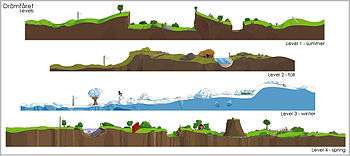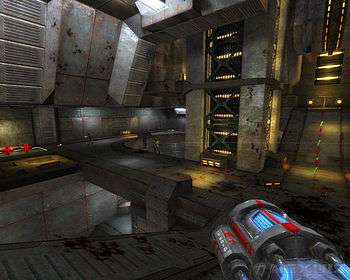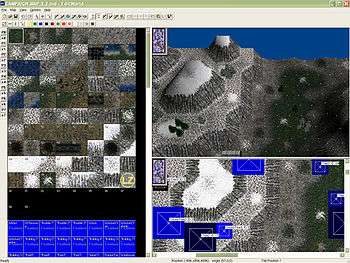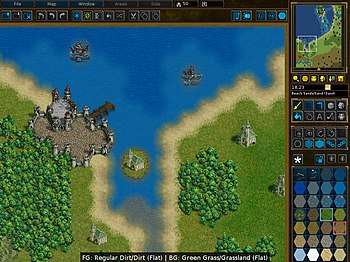Level (video games)
A level, map, area, stage, world, track, board, floor, zone, phase, mission, episode, or course in a video game is the total space available to the player during the course of completing a discrete objective. Video game levels generally have progressively increasing difficulty to appeal to players with different skill levels.[1] Each level presents new content and challenges to keep player's interest high.[1]
| Part of a series on the: |
| Video game industry |
|---|
|
Activities/jobs
|
|
|
Types |
|
Related |
In games with linear progression, levels are areas of a larger world, such as Green Hill Zone. Games may also feature interconnected levels, representing locations.[2] Although the challenge in a game is often to defeat some sort of character, levels are sometimes designed with a movement challenge, such as a jumping puzzle, a form of obstacle course.[3] Players must judge the distance between platforms or ledges and safely jump between them to reach the next area.[4] These puzzles can slow the momentum down for players of fast action games;[5] the first Half-Life's penultimate chapter, "Interloper", featured multiple moving platforms high in the air with enemies firing at the player from all sides.[6]
Level design
Level design, or environment design,[7] is a discipline of game development involving creation of video game levels—locales, stages, or missions.[8][9][10] This is commonly done using a level editor, a game development software designed for building levels; however, some games feature built-in level editing tools.
_level_layout.png) Layout of a level in the puzzle game Edge
Layout of a level in the puzzle game Edge Different levels in a 2D computer graphics game layout
Different levels in a 2D computer graphics game layout
History
In early days of video games, a single programmer would create the maps and layouts for a game, and a discipline or profession dedicated solely to level design did not exist.[10][11][12] Early games often featured a level system of ascending difficulty as opposed to progression of story-line.[10]
The first game genre that required significant amounts of time to design areas were text-based games,[13] such as MUDs. Often, promoted users were assigned to create new paths, new rooms, new equipment, and new actions, often using the game interface itself.
1983's Lode Runner was one of the first titles to ship with a level editor,[14][15] and its designer, Doug Smith, reputedly paid neighborhood children to design levels for the game. That same year the multiplayer dungeon crawl Dandy was released, and it also shipped with a level editor which was documented in the manual.[16] ZZT (1991) is a later game with user-accessible mapping and scripting.[17]
Doom (1993) and Doom II (1994) were two of the first games to attract focused game modding activity, and many WAD level files were made for them.[13] One of the reasons was a clear separation between the level files and game engine itself.[13] Half-Life, Quake 3, and many other games have notable mapping tools and communities focusing on user-generated content.
Process
Level design for each individual level in a modern game typically starts with concept art, sketches, renderings, and physical models.[18][19] Once completed, these concepts transform into extensive documentation, environment modeling, and the placing of game specific entities (actors), usually with the aid of a level editor.
A level editor may be distributed as a complete stand-alone package, at times, rivaling commercial 3D modelling software.[11] There are various steps involved in laying out a map and these steps may vary dramatically across the many different game genres that exist today.
General steps include:
- Laying out the large-scale features of the map, such as hills, cities, rooms, tunnels, etc., for players and enemies to move around in;[20]
- Determining environmental conditions and "ground rules" such as day/night, weather, scoring systems, allowable weapons or gameplay types, time limits, and starting resources.
- Specifying certain regions where certain gameplay activities or behaviors occur, such as resource harvesting, base building, water travelling, etc.;
- Specifying non-static parts of a level, such as doors, keys and buttons with associated mechanisms, teleporters, hidden passageways, etc.;
- Specifying locations of various entities, such as player units, enemies, monster spawn points, ladders, coins, resource nodes, weapons, save points,[21] etc.;
- Specifying the start and exit locations for one or more players;
- Adding aesthetic details such as level-specific graphic textures, sounds, animation, lighting and music;
- Introducing scripted event locations, where certain actions by the player can trigger specified changes;
- Placing pathfinding nodes that non-player characters take as they walk around, the actions they will take in response to specific triggers, and any dialog they might have with the player.[11]
The first level of the game usually designed to get players to explore the mechanics of the game, notably in World 1-1 of Super Mario Bros.[22]
Cut scenes may be triggered by events in a level, but require distinctly different skills, and may be created by a different person or team.
The Level Design Process may be iterated several times before achieving the desired outcome.[11]
Level designers and/or concept artists may also be required to provide a pre-rendered map of the level (or entire game world) for the player.[23]
Design goals
Level design is necessary for two primary purposes - providing players with a goal[24] and providing players with enjoyable play experience. Good level design strives to produce quality gameplay, provide an immersive experience, and sometimes, especially in story-based games, to advance the storyline. Skilled use of textures and audio is necessary to produce immersive player experience.
Player directing
Levels are generally constructed with flow control in mind,[25] that is directing the player towards the goal of the level and preventing confusion and idling. This can be accomplished by various means.
Often the level layouts features power-ups and items aligned in path and combinations that collecting them inevitably progresses the game and advances the story-line. This is one of the basic player direction technique and is most often seen in platformers.
Lighting and illumination, as well as distinctly coloured objects are often used to unambiguously steer the player towards the correct path. Similarly, clearly marked choke-points can be introduced.
Another method is strategic placement of obstacles and aesthetic environment props, that direct the player's attention to "clear" paths instead. This is often used in closed, "stuffed" environments.
Levels may be designed to force the players to explore the map and advance. Most RTS maps give each player a starting base, but will have resource distribution and terrain features designed to draw players out of their base and engage each other. Teamplay maps can provide noticeable advantages to one team over another, when designed poorly.
Level designer
A level designer is a game designer who creates environments and scenarios using a level editor and other tools.[10][26] Level designers will usually work on a level from pre-production to completion; working with both incomplete and complete versions of the game. Video game programmers usually produce level editors and design tools for the designers to use. This eliminates the need for designers to access or modify game code. As opposed to the level editing tools sometimes available to the community, level designers often work with placeholders and prototypes aiming for level consistency and clear layout before required artwork is produced by game artists. Many level designers have skills as both a visual artist and game designers,[11][26][27] although in recent years the responsibility for visual, structural and gameplay related tasks has been increasingly divided among several specialists.
Level creation tools
A wide variety of tools may be used by someone designing and creating a level. Although it is faster to design models and textures with general purpose multimedia creation tools, games usually require the data to be in a unique format suited for that game's engine. For this, specific compilers and converters of models, textures, and audio data may be required to lay out a level.
Sometimes, professional 3D editing software, such as 3D Studio Max, Blender, AutoCAD, Lightwave, Maya, Softimage XSI or Grome is used, usually customized with a special plugin developed for the specific game.
Level Editor
A level editor (also known as a map, campaign or scenario editor) is a game development tool used to design levels, maps, campaigns and virtual worlds for a video game. An individual involved with the creation of game levels is a level designer or mapper.
In some cases, the creator of a video game includes built-in level editing tools, for example, a track editor for a racing game. Other times they may release an official level editor for the game as a separate application. Sometimes players of the game create fan-made level editors.
One of the first 3D games which became popular partially due to level editors and fan-made content was Doom. The creation of various third-party editors led to the birth of an online community trading fan-made maps.[28]
A level editor is often limited to creating levels for only a certain game engine. Developing a level editor takes a lot of time and it is more time and cost efficient to release multiple games using the same engine instead of developing a new engine and level editor for each game. Level editors offer some limited scope of content creation, but in the case of gaming industry solutions the scope is very large allowing an entire game to be created without the need for much support from a programming team. To make larger changes to a game than simply adding new levels, a software development kit (SDK) is sometimes needed.
 The level editor of Warzone 2100.
The level editor of Warzone 2100. A level editor in the strategy game Warzone 2100
A level editor in the strategy game Warzone 2100 Example map editor for The Battle for Wesnoth.
Example map editor for The Battle for Wesnoth.
| Wikimedia Commons has media related to Level editors. |
Construction set
In the early years of video-gaming, some games came with a utility called a "construction set". This was similar in many ways to a level-editor. Some games used them to create extra levels, whereas others (like the Shoot-'Em-Up Construction Kit) used them as a means to create a game rather than be a game in itself.
Tutorial
In the context of video game design, a tutorial is a video game level that teaches players the rules and controls of the game. Some tutorials are integrated into the game itself, while others are completely separate and optional. Games can have both of these at once, offering a basic mandatory tutorial and optional advanced training. Tutorials have become increasingly common due to the decline of printed video game manuals as a result of cost cutting and digital distribution. Tutorials can be important since they are a player's first impression of a game, and an overly tedious tutorial or one that does not allow for player freedom can negatively affect their view of a game. However, the lack of a tutorial can also harm a game by causing the player to become frustrated, since they cannot figure out essential game mechanics.
Types of tutorials
Tutorials range from gently easing the player into the experience, to forcing them to learn via trial and error, only allowing them to proceed when they have mastered the gameplay. The former type is often framed as guidance from a mentor character, such as a wise old man or elderly master, and sometimes even literally depicts the main character growing from a child into an adult as they learn their skills, as in Horizon Zero Dawn.[29] The latter type of tutorial presents the player with increasingly difficult enemies that demonstrate techniques required to overcome them.[29] Other types of tutorials include slowly giving players information over the course of the entire game, as in the Legend of Zelda series.[29]
Yet other games break the fourth wall with their tutorials or parody them, using them as a source of comedy. Examples include Far Cry 3: Blood Dragon, in which the main character demonstrates his annoyance at being forced to undergo a tutorial,[29][30] and Undertale, in which the motherly Toriel dotes on the player character so much that she literally holds their hand through dangerous puzzles instead of allowing the player to solve them.
Gameplay alteration
Maps' design can significantly impact the gameplay.[24] For example, the gameplay may be shifted towards a platformer (by careful placement of platforms) or a puzzle game[33][34] (by extensive use of buttons, keys, and doors). Some FPS maps may be designed to prevent sniping by not including any long hallways, while other maps may allow for a mix of sniping and closer combat.
Gimmick maps are sometimes created to explore selected features of gameplay, such as sniping or fist fighting.[35] While they are briefly useful to level designers and interesting to experienced players, they are usually not included in final list of levels of the game because of their limited replay value.
Minigame
A minigame (also spelled mini-game or mini game, sometimes called a subgame or microgame) is a short video game often contained within another video game, and sometimes in application software or on a display of any form of hardware. A minigame contains different gameplay elements than the main game, may be optional, and is often smaller or more simplistic than the game in which it is contained. Minigames are sometimes also offered separately for free to promote the main game. Some minigames can also be bonus stages or secret levels. They are distinguishable from levels in that a level is an environment bound to a set of mechanics and rules that all defines all other normal levels in a game, whereas a minigame can use different rules and playstyles but may not necessarily be set in a different environment.
Hidden features
Level designers sometimes create hidden rooms and areas that usually require more effort for the player to reach or to notice.[36] These usually give some additional rewards, such as ammo or powerups. Casual players usually do not discover these, but these areas are interesting enough to be discovered and documented by dedicated gamers. Sometimes, they serve as easter eggs,[36] containing messages such as the level designers' names or pictures, or political or humorous messages. One of the first games with a 3D engine to feature hidden features was Wolfenstein 3D, where certain walls could be "pushed" to reveal hidden passages.[36] For example, Quake has many secret areas that reward the player with ammo, weapons, quad damage powerups, and in one hard-to-reach secret area, Dopefish makes an appearance. In fact, the hardest difficulty level, titled "Nightmare", is only reachable through a secret portal in the fourth dimension's entrance hall.
Sometimes, a whole level may be designed as a secret level.
Bonus stage
A bonus stage (also known as a bonus level or bonus round) is a special level within a video game designed to reward the player or players, and typically allows the player to collect extra points or power-ups. Bonus stage either have no enemies or hazards, or replace the normal penalties for being struck by enemies or hazards with simply being thrown out of the bonus stage. Many bonus stages need to be activated or discovered in some manner, or certain conditions must be satisfied to access them. Otherwise, they appear after the player has completed a certain number of regular stages.[37]
Level bugs
There are many map bugs that level designers try to avoid, but sometimes go unnoticed for some time.
A player might get stuck in map geometry with no way to escape or to die. A player might be able to find a specific spot where they do not have to move to gain experience, because monsters are constantly spawned but can be easily and immediately killed. In multiplayer maps, a player may be able to reach areas of the map designed to be inaccessible, for example, reaching an advantageous rooftop position and camping other players. In the worst case, a player might be able to fall out-of-bounds of a map where other players cannot reach them. Invisible walls are cited to be level design bugs, and might be "left-over geometry" from an earlier version of the level or an object's improperly aligned "collision box".[38]
In some cases, specific mapping tools can be designed to automatically detect problems such as falling "outside" a level, and reaching "stuck" areas. Careful level designers run these tools as the last step before releasing a new version of a level.[39] In most cases, the best way to improve a map is by playtesting it with experienced players, and allowing them to try to exploit any problems.
Notable levels
- Green Hill Zone
- World 1-1
- Blood Gulch
- The Goat Puzzle
- No Russian
- Minus World
- Milkman Conspiracy
- Water Temple (Ocarina of Time)
- The Silent Cartographer
- Robbing the Cradle
- Le Serpent Rouge puzzle
- Inverted Castle
- Effect and Cause
- Dust II
- Cat hair mustache puzzle
- Anor Londo
- All Ghillied Up
- 2Fort
See also
- Online creation
- Mod (video gaming)
- ROM hacking
- List of gaming topics
Sources
- Scott Rogers (16 April 2014). Level Up! The Guide to Great Video Game Design. Wiley. ISBN 978-1-118-87719-7.
- Lewis Pulsipher (25 July 2012). Game Design: How to Create Video and Tabletop Games, Start to Finish. McFarland. ISBN 978-0-7864-9105-6.
- Guy W. Lecky-Thompson (1 January 2008). Video Game Design Revealed. Cengage Learning. ISBN 1-58450-607-5.
- Bates, Bob (2004). Game Design (2nd ed.). Thomson Course Technology. ISBN 1-59200-493-8.
- Brathwaite, Brenda; Schreiber, Ian (2009). Challenges for Game Designers. Charles River Media. ISBN 1-58450-580-X.
- Moore, Michael E.; Novak, Jeannie (2010). Game Industry Career Guide. Delmar: Cengage Learning. ISBN 978-1-4283-7647-2.
- Oxland, Kevin (2004). Gameplay and design. Addison Wesley. ISBN 0-321-20467-0.
- Shahrani, Sam (April 25, 2006). "Educational Feature: A History and Analysis of Level Design in 3D Computer Games". Retrieved 5 January 2011.
- Brathwaite, Brenda; Schreiber, Ian (2009). Challenges for Game Designers. Charles River Media. ISBN 1-58450-580-X.
References
- Schell, Jesse (2014). The Art of Game Design: A book of lenses. Pittsburgh, Pennsylvania, USA: CRC Press. pp. 120, 252. Retrieved 30 December 2017.
- McGuire, Morgan; Jenkins, Odest Chadwicke (2009). Creating Games: Mechanics, Content, and Technology. Wellesley, Mass.: AK Peters. p. 104. ISBN 978-1-56881-305-9.
- Jamie "Thrrrpptt!" Madigan (June 2001). "Half-Life: Blue Shift". Archived from the original on December 16, 2008. Retrieved 2009-04-02.
- Andrew Park (2002-10-11). "Batman: Vengeance Review". GameSpot. Retrieved 2009-04-02.
- Kevin VanOrd (2008-11-11). "Mirror's Edge Review". GameSpot. Retrieved 2009-04-02.
- "Chapter XVII: Interloper". GameSpy. Archived from the original on 2011-08-08. Retrieved 2009-03-27.
- Oxland 2004, pp.21-22,126
- Bates 2004, p.107
- Brathwaite, Schreiber 2009, p.5
- Shahrani 2006, part I
- Bleszinski, Cliff (2000). "The Art and Science of Level Design". Archived from the original on 3 December 2002. Retrieved 29 March 2010.
- Bates 2004, p.162, "A few years ago, [level designer] position didn't exist. .. Now it's a key position on many teams."
- Shahrani 2006, part III
- "Lode Runner Contest", Computer Gaming World, p. 22, August 1984
- "Lock'n'Lode". IGN. February 17, 1999. Archived from the original on December 18, 2009. Retrieved March 29, 2010.
- "Dandy". Atari Mania.
- "ZZT". Everything2. April 25, 2003. Retrieved March 29, 2010.
- Bates 2004, p.107-110
- Oxland 2004, pp.132-135
- Oxland 2004, pp.128-130
- Oxland 2004, p.139
- Parish, Jeremy (2012). "Learning Through Level Design with Mario". 1UP.com.
- Oxland 2004, pp.140-141
- Bates 2004, pp.111-112
- Bates 2004, pp.113-114
- Moore, Novak 2010, p.76
- Bates 2004, p.118
- Herwig, Adrian; Paar, Philip. "Game Engines: Tools for Landscape Visualization and Planning?" (PDF). CiteSeerX 10.1.1.134.75. Archived from the original (pdf) on 2017-08-09. Retrieved 2020-02-07.
- Peacock, Nathanael (2017-08-27). "What Makes a Great Tutorial?". IGN. Retrieved 2019-05-10.
- "This Is The Best/Worst Video Game Tutorial I Have Ever Had To Play". Kotaku Australia. 2013-05-03. Retrieved 2019-05-10.
- Teti, John. "What's the worst game tutorial you've played?". Games. Retrieved 2019-05-10.
- "Gaming Tutorials Can Tread A Thin Line Between Instructive & Patronizing". Game Rant. 2015-08-08. Retrieved 2019-05-10.
- Bates 2004, pp.116
- Brathwaite, Schreiber 2009, p.48
- Bates 2004, p.108
- Shahrani 2006, part II
- "The Next Generation 1996 Lexicon A to Z". Next Generation. No. 15. Imagine Media. March 1996. p. 30.
Typically, bonus levels are either hidden and require discovery or appear after a certain number of regular levels have been completed.
- Levy, Luis; Novak, Jeannie (2009-06-22). Game Development Essentials: Game QA & Testing. Cengage Learning. p. 84. ISBN 1435439473. Retrieved 2014-11-18.
- Bates 2004, pp.117-118